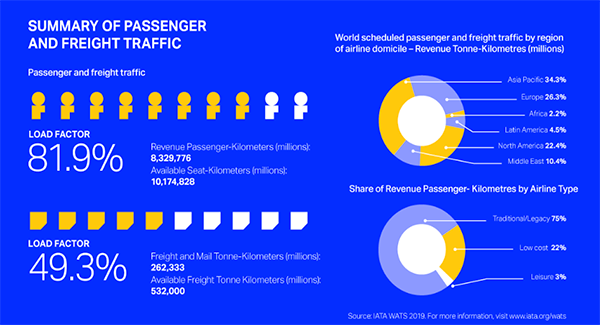Air freight volumes grew modestly in 2018 as global trade volume slows
Following a very strong year in 2017, air freight volumes grew more modestly in 2018 in line with slowing global trade volumes, an industry report said today.
Globally, freight and mail ton kilometers (FTKs) showed a 3.4 percent expansion in 2018 as compared to a 9.7 percent rise in 2017, according to the report from the International Air Transport Association (IATA).
Air cargo capacity grew faster than volume, climbing 5.2 percent in 2018, and leading to a decrease in the freight load factor, which fell by 0.8 percentage points to 49.3 percent, IATA's "World Air Transport Statistics (2019 WATS)" found.
FedEx Corp. held a secure lead as the world's busiest air cargo carrier, the report showed. The top five airlines ranked by scheduled FTKs flown were: FedEx (17.5 billion), Emirates (12.7 billion), Qatar Airways (12.7 billion), UPS Inc. (12.5 billion), and Cathay Pacific Airways (11.3 billion).
The gradual slowdown in air freight echoed a number of other recent reports showing a cooling global economy, exacerbated by the trade war between the U.S. and China.
The IATA report also summarized the passenger sector, which showed that airlines carried 4.4 billion passengers on scheduled services in 2018, an increase of 6.9 percent over 2017, representing an additional 284 million trips by air. Capacity utilization for passenger flights was also high, reaching record efficiency with 81.9 percent of available seats being filled, the report found.
Ranked by total scheduled passenger kilometers flown, the top five passenger carriers were: American Airlines (330.6 billion), Delta Air Lines (330 billion), United Airlines (329.6 billion), Emirates (302.3 billion), and Southwest Airlines (214.6 billion).
Fuel efficiency improved industry-wide by more than 12 percent compared to 2010, thanks to sustainable aviation fuels, new technology, and more efficient routes. But IATA leaders said the sector still has plenty of room for improvement, and called for government support to help meet their climate action goals.
"Airlines are connecting more people and places than ever before. The freedom to fly is more accessible than ever. And our world is a more prosperous place as a result. As with any human activity this comes with an environmental cost that airlines are committed to reducing," Alexandre de Juniac, IATA's Director General and CEO, said in a release.
"We understand that sustainability is essential to our license to spread aviation's benefits," de Juniac said. "From 2020 we will cap net carbon emissions growth. And, by 2050, we will cut our net carbon footprint to half 2005 levels."
Can you rank the 6 regions on map below in order of most carried passengers to least (according to IATA's annual publication on World Air Transport Statistics). You can ?? your answers on news release at this link. https://t.co/vypzDPDf9v pic.twitter.com/kNsJYT02wF
— IATA (@IATA) July 31, 2019
Related Articles
Copyright ©2024. All Rights ReservedDesign, CMS, Hosting & Web Development :: ePublishing